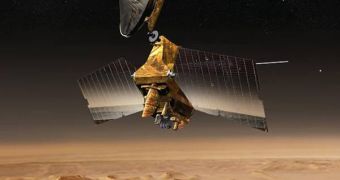According to mission managers at the Jet Propulsion Laboratory (JPL), in Pasadena, California, the powerful NASA-operated Mars Reconnaissance Orbiter (MRO) was finally pulled off of the backup computer it was forced to relay on last week. Its main systems exhibited a bizarre error, which sent the spacecraft in safe mode, for at least the third time this year alone. Experts then had to use the back-up system, so as to get access to at least a small portion of the craft's capabilities. On Monday, the team succeeded in reverting back to the original computer, and announced that measurements had been resumed.
The MRO is simply invaluable to the American space agency. While it is the most recent orbiter sent to the planet, having arrived there in 2006, it is also the most powerful observatory in Martian orbit, having already sent back more images and data than all other Mars-bound missions combined. However, since its launch, it experienced some seven such incidents, in which it entered safe mode for no apparent reason. In two of these instances, one in 2007, the other in 2008, it also started its back-up computer, and JPL scientists say that these two events are related to the most recent one.
Engineers were able to stop the back-up computer on Saturday, and restarted the primary one the same day. The craft had started showing signs of trouble since Thursday, and so it spent a couple of days drifting away in Martian orbit, awaiting instructions from Earth. By Monday, JPL mission managers had already succeeded in restarting the observatory's scientific instruments as well, so that full-scale scientific observations could be resumed, Space informs.
The MRO, which took about $720 million to build, has had several mishaps while in Martian orbit, yet continues to provide invaluable data to mission controllers. Recently, it assisted JPL engineers in assessing Spirit's situation, as the rover was stuck inside a loose patch of soil and sand called Troy. For this objective, the craft used its High Resolution Imaging Science Experiment (HiRise) camera, which gave those in charge of extricating the rover a good idea of how the landscape around the robot looks like.

 14 DAY TRIAL //
14 DAY TRIAL //